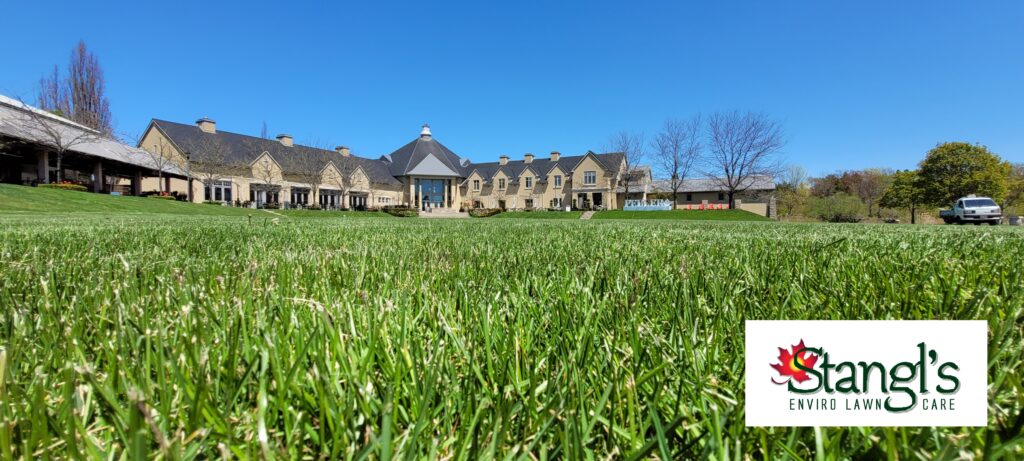Introduction:
Regenerative lawn care isn’t just about individual actions; it’s about understanding and enhancing a system where every component – soil, plants, microbes, water, and human intervention – interacts synergistically. Drawing from the insights of Dr. James White on plant-microbe symbiosis, Glen Ravenberg’s practical soil management, and Dr. Thomas Dykstra’s understanding of plant health via Brix levels, we at Stangl’s Enviro Lawn Care are pioneering a systemic approach. Here’s how we leverage Nature’s Brew, alongside other practices, to propel lawn ecosystems towards health and resilience.
Systems Thinking in Action:
- Soil as a Living Ecosystem: Dr. James White’s research on the rhizophagy cycle informs our understanding that plants and soil microbes are in a constant exchange. Nature’s Brew serves as food for this microbial community, stimulating a feedback loop where increased microbial activity leads to more plant exudates. This interaction is the cornerstone of our strategy, where each application of Nature’s Brew not only feeds the biology but also triggers the plant to “leap frog” its own growth and health by enhancing nutrient and water uptake.
- Feedback Loops and Compaction: Glen Ravenberg’s emphasis on soil structure and compaction reduction aligns with our use of GSR calcium. By breaking up compacted soil, we create an environment where water and air infiltration improve, which in turn supports microbial life. This is not a one-off action but part of an ongoing process where improved soil structure leads to better root penetration, enhancing the entire system’s resilience and productivity.
- Plant Health and Brix Levels: Dr. Thomas Dykstra’s work on Brix levels provides a metric for plant health and vigor. Higher Brix indicates a plant capable of defending itself against pests and diseases, which is facilitated by the nutrient-rich, biologically active soil we aim to cultivate. When we see an increase in Brix following our treatments, it’s a sign that the system is functioning more harmoniously, with plants producing more sugars and secondary metabolites.
Leap Frogging the System:
- Catalyzing Growth and Health: Each application of Nature’s Brew is designed to catalyze this cycle of growth and health. As the biology in the soil flourishes, it supports plant processes that were previously hindered, essentially “leap frogging” the system from one state of health to another, more robust one.
- Increasing Infiltration: By improving soil structure, we enhance water infiltration, which is crucial for soil biology and plant health. This not only supports immediate plant growth but also builds soil’s capacity to retain moisture, reducing the need for frequent watering and aiding in drought resistance.
- Momentum through Regeneration: Each visit and treatment adds momentum to the regenerative processes. The system begins to self-regulate more effectively, with each component enhancing the others. For example, healthier plants contribute more organic matter to the soil through roots and biomass, which further supports microbial communities.
Outcomes and Challenges:
- Holistic Improvements: The outcomes are not just healthier lawns but a whole ecosystem where soil, plant, and microbial health are interconnected. We see reduced weed pressure, fewer pest and disease issues, and a lawn that’s more resilient to environmental stresses.
- Systemic Challenges: However, this approach isn’t without challenges. External factors like weather, soil type variations, or previous chemical treatments can disrupt the balance. We must be adaptive, learning from each interaction with the system to refine our methods.
- Continual Learning and Adaptation: Each visit is an opportunity to learn more about the system’s response, allowing us to adjust our strategy to minimize disturbances and maximize positive outcomes. This might mean altering the frequency of Nature’s Brew applications or integrating new biological agents based on observed soil and plant health metrics.
Conclusion:
Regenerative lawn care through a systems thinking approach is about understanding the web of interactions within a lawn’s ecosystem. By leveraging the collective wisdom of White, Ravenberg, and Dykstra, we not only aim to grow grass but to cultivate a living, dynamic environment. Our method with Nature’s Brew, combined with other regenerative practices, sets in motion a cycle of continuous improvement, where each element of the system supports and amplifies the others, leading to sustainable, vibrant lawns that are a testament to ecological stewardship.
